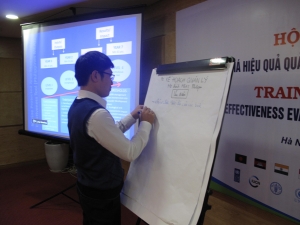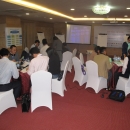Assessing MPA management effectiveness
MPA workshop: Assessing MPA management effectiveness
Location: Ha Noi, Viet Nam . 30th Dec 2014
With this in mind, IUCN will, with funding from Mangroves for the Future (MFF), carry out a management effectiveness evaluation (MEE) of the eight more or less operational MPAs and two national parks that include marine areas (Bai Tu Long and Ha Long Bay). The first step in this process was a 2-day workshop in Hanoi in December, which was attended by participants from 10 of these sites (Nha Tang Bay, Cu Lao Cham, Phu Quoc, Con Dao, Cat Ba, Nui Chua, Con Co, Hon Cau, Bai Tu Long, and Ha Long Bay) and facilitated by Anne Walton, an MPA specialist who works for the National Oceanographic and Atmospheric Administration (NOAA) in the United States.
Anne opened the workshop by pointing out that the challenges that Vietnam’s MPAs face are similar to those faced by MPAs across the world; that MPA managers need to think creatively and leverage their strengths to overcome obstacles; and that MEE can be used to set management standards across the MPA network, thereby allow managers to assess their MPA against these standards and take action accordingly. Anne then presented four types of MEE model and eight case studies that have been applied in Thailand, Philippines, Indonesia, USA, and across an array of global MPA networks.
While participants generally agreed that a focus on management effectiveness is necessary, some were skeptical about whether or not it could be implemented. A common response was that external factors, notably lack of funding, an incomplete legal framework, and a mismatch between MPA responsibility and authority are more important that internal management capacity in determining the state of the MPA. This implies that nothing can be improved until everything is perfect—in other words, their ability to implement a MEE model is uncertain.
Yet simple observation indicates that progress is possible. Vietnam’s protected areas in general receive high levels of funding compared to other countries in the region and some MPAs, notably Cu Lao Cham, have secured significant financial and political support from the province and maximized local community participation in MPA design and management (particularly of the strictly protected zone where all fishing is banned), thereby increasing compliance. Cu Lao Cham has also engaged a wide range of research organizations that effectively serve as advocates for the MPA.
MPAs often claim that they can’t deal with illegal fishers but opportunities are clearly being missed. Several have signed MOUs with the Border Guard (Bien Phong) but none seem to be active, despite the modest cost of such assistance. It is evident that MPA managers need to be, among many other things, effective salesmen, marketing their MPAs to political leaders for the valuable services they provide, including tourism revenue, fish stock enhancement, and prestige.
How can MPA managers make the most of what they have? Anne gave an example of Chendarwasi, an MPA in a very remote part of Indonesia that tagged nesting turtles, some of which swam as far as California. MPAs in California are now champions of protecting this shared resource and entering into a “sister sanctuary” relationship with Chendarwasi, providing technical and financial support. These are the kinds of intangible benefits that managers need to build on rather than remain impassive until adequate funding and legislation are present.
After the workshop, Anne and several MPA managers visited Cu Lao Cham to discuss how to tailor an MEE model to conditions in Vietnam. They broke down and examined the components of each MEE model to identify what may be relevant, gathering input from the MPA managers on how it might be implemented at their site. They came up with a model that draws on MEE systems prepared by NOAA and IUCN.
In early 2015, an IUCN team will visit all 10 focal MPAs to test this model. The results will be used to identify specific management problems (and solutions) in each MPA and to create standardized management procedures across all MPAs, thereby supporting the emergence of a national MPA system. The results will be presented at a national workshop in April 2015.

